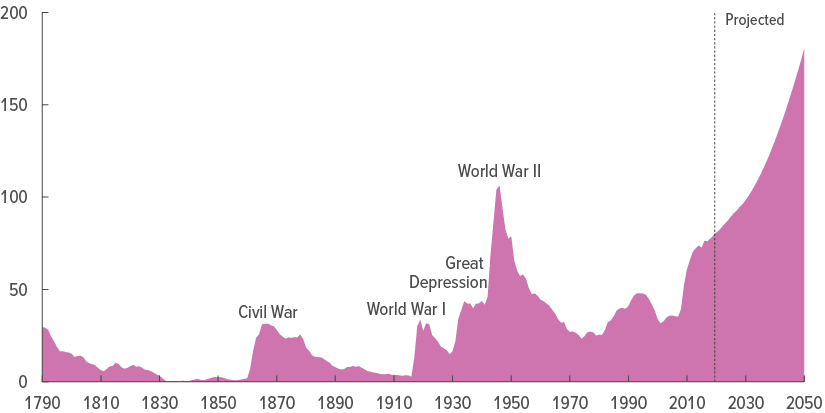In our projections, which incorporate the assumption that current laws governing taxes and spending generally remain unchanged, the federal budget deficit is $1.0 trillion this year and averages $1.3 trillion per year between 2021 and 2030. Measured as a percentage of economic output, the deficit widens from 4.6 percent of GDP in 2020 to 5.4 percent in 2030. Over the past 50 years, the average annual deficit equaled 3.0 percent of GDP, and it was generally much smaller when the economy was strong.
Revenues will grow in our expanding economy. If current laws did not change, federal revenues would rise from 16.4 percent of GDP in 2020 to 18.0 percent of GDP in 2030. Those projections reflect a scheduled increase in individual income taxes at the end of 2025, among other things.
Spending is projected to grow more than revenues, widening the gap between the two. In our projections, federal outlays climb from 21.0 percent of GDP to 23.4 percent over the next decade. That growth has two sources: increased spending for mandatory programs and interest on federal debt.
The increase in mandatory outlays over the decade—from 12.9 percent of GDP to 15.2 percent—is attributable partly to the aging of the population. Another major factor is the growth of health care costs, which has slowed in recent years but is still projected to be faster than economic growth. Those two long-term trends affect Social Security and Medicare in particular, and they are expected to persist beyond 2030.
As for the increase in interest spending, one of its causes is the large deficits, which lead the federal government to borrow more each year in our projections. Another cause is rising interest rates over the next decade. All in all, the federal government’s net interest outlays are projected to increase from 1.7 percent of GDP in 2020 to 2.6 percent in 2030.
As a result of the persistently large deficits, federal debt held by the public is projected to rise to $31.4 trillion at the end of 2030—an amount equal to 98 percent of GDP. At that point, debt would be higher as a percentage of GDP than at any point since just after World War II and more than double what it has averaged over the past 50 years. We project that the gap between spending and revenues would continue to widen over the following two decades and that debt would reach 180 percent of GDP by 2050, well above the highest percentage ever recorded in the United States. And it would be headed still higher.
Federal Debt Held by Public as Percent GDP:
